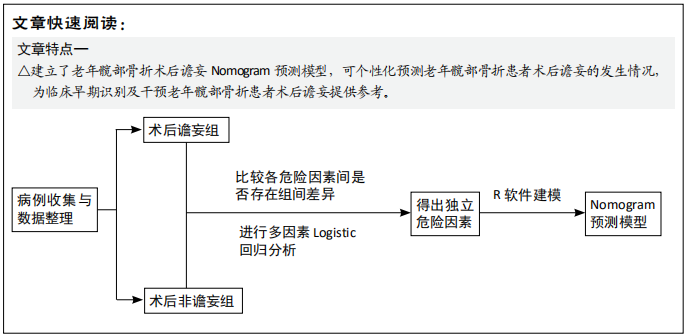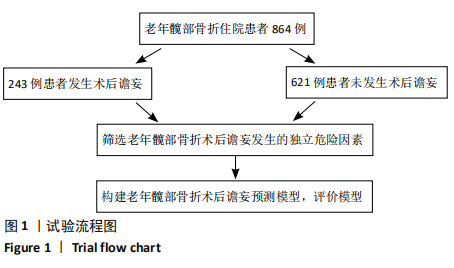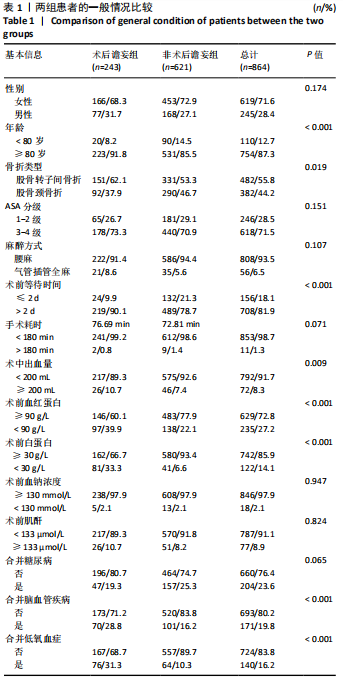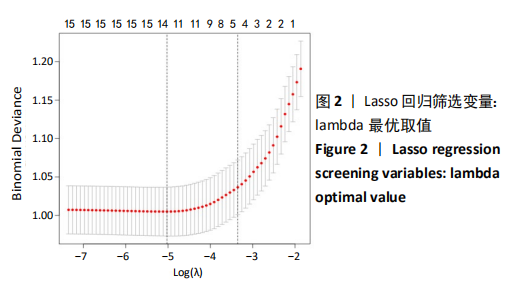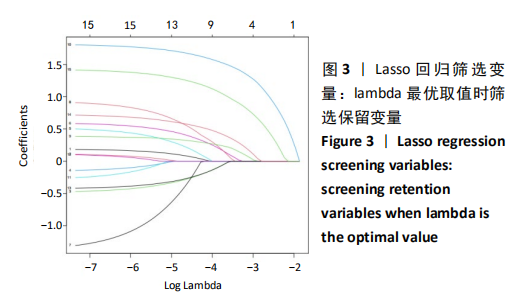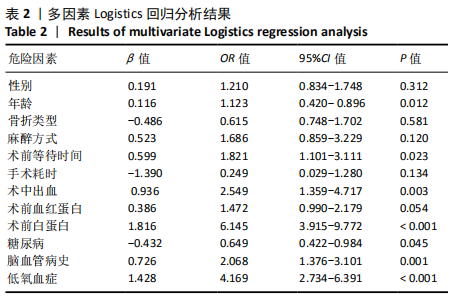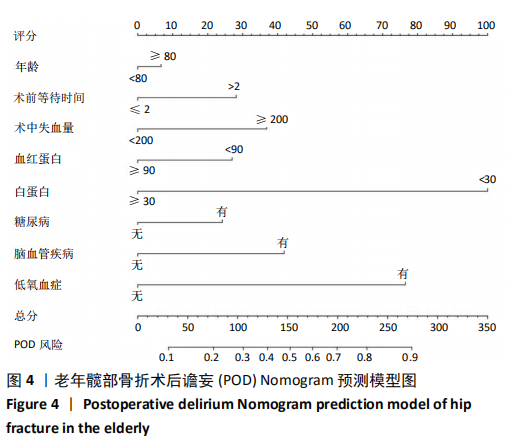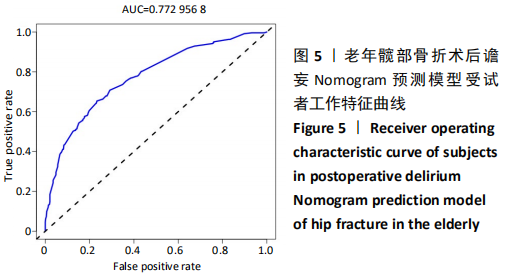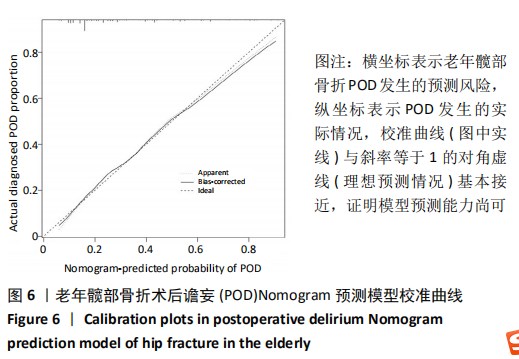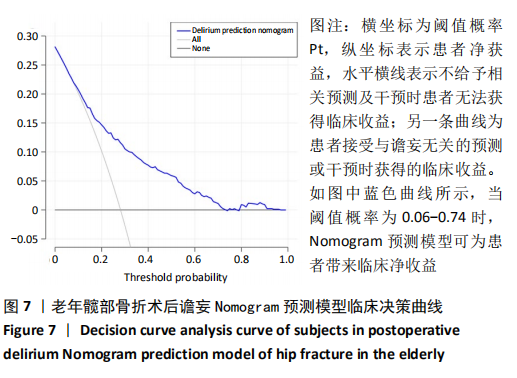[1] 张长青,张伟.对老年髋部骨折救治绿色通道建设的思考与展望[J].中华创伤骨科杂志,2015,17(2):95-96.
[2] 吴新宝,杨明辉.老年髋部骨折诊疗专家共识(2017)[J].中华创伤骨科杂志,2017,19(11):921-927.
[3] SEZGIN EA, MARKEVIČIŪTĖ V, ŠIRKA A, et al. Combined fracture and mortality risk evaluation for stratifying treatment in hip fracture patients: A feasibility study. Jt Dis Relat Surg. 2020;31(2):163-168.
[4] RUDOLPH JL, MARCANTONIO ER. Review articles: postoperative delirium: acute change with long-term implications. Anesth Analg. 2011;112(5):1202-1211.
[5] AMARILLA-DONOSO FJ, LÓPEZ-ESPUELA F, RONCERO-MARTÍN R, et al. Quality of life in elderly people after a hip fracture: a prospective study. Health Qual Life Outcomes. 2020;18(1):71.
[6] ZENILMAN ME. Delirium: An Important Postoperative Complication. JAMA. 2017;317(1):77-78.
[7] EASTHAM JA, KATTAN MW, SCARDINO PT. Nomograms as predictive models. Semin Urol Oncol. 2002;20(2):108-115.
[8] WEI LA, FEARING MA, STERNBERG EJ, et al. The Confusion Assessment Method: A Systematic Review of Current Usage. J Am Geriatr Soc. 2008;56(5):823-830.
[9] LEE SR, HA YC, KANG H, et al. Morbidity and mortality in Jeju residents over 50-years of age with hip fracture with mean 6-year follow-up: a prospective cohort study. J Korean Med Sci. 2013;28(7):1089-1094.
[10] SCHOLTENS RM, VAN MUNSTER BC, VAN FAASSEN M, et al. Plasma melatonin levels in hip fracture patients with and without delirium: A confirmation study. Mech Ageing Dev. 2017;167:1-4.
[11] OH ES, SIEBER FE, LEOUTSAKOS JM, et al. Sex Differences in Hip Fracture Surgery: Preoperative Risk Factors for Delirium and Postoperative Outcomes. J Am Geriatr Soc. 2016;64(8):1616-1621.
[12] WITLOX J, EURELINGS LS, de JONGHE JF, et al. Delirium in elderly patients and the risk of postdischarge mortality, institutionalization, and dementia: a meta-analysis. JAMA. 2010;304(4):443-451.
[13] ZYWIEL MG, HURLEY RT, PERRUCCIO AV, et al. Health economic implications of perioperative delirium in older patients after surgery for a fragility hip fracture. J Bone Joint Surg Am. 2015;97(10):829-836.
[14] 王晓伟,孙天胜,刘智,等.老年髋部骨折后发生谵妄的研究现状[J].中华骨科杂志,2016,36(13):871-875.
[15] WANG Y, SHEN X. Postoperative delirium in the elderly: the potential neuropathogenesis. Aging Clin Exp Res. 2018;30(11):1287-1295.
[16] MALDONADO JR. Pathoetiological Model of Delirium: a Comprehensive Understanding of the Neurobiology of Delirium and an Evidence-Based Approach to Prevention and Treatment. Crit Care Clin. 2008;24(4): 789-856.
[17] BEHRENDS M, DEPALMA G, SANDS L, et al. Association between intraoperative blood transfusions and early postoperative delirium in older adults. J Am Geriatr Soc. 2013;61(3):365-370.
[18] 李呈凯,白树财,宋秀钢,等.老年髋部骨折患者术后谵妄相关危险因素的回顾性研究[J].中华骨科杂志,2018,38(4):250-256.
[19] YANG Y, ZHAO X, DONG T, et al. Risk factors for postoperative delirium following hip fracture repair in elderly patients: a systematic review and meta-analysis. Aging Clin Exp Res. 2017;29(2):115-126.
[20] LAKSTYGAL AM, KOLESNIKOVA TO, KHATSKO SL, et al. DARK Classics in Chemical Neuroscience: Atropine, Scopolamine, and Other Anticholinergic Deliriant Hallucinogens. ACS Chem Neurosci.2019;10(5): 2144-2159.
[21] 沈亚骏,范磊,王云华,等.老年髋部骨折术后谵妄危险因素分析[J].实用老年医学,2019,33(10):979-982.
[22] MAHESHWARI K, PLANCHARD J, YOU J, et al. Early Surgery Confers 1-Year Mortality Benefit in Hip-Fracture Patients. J Orthop Trauma. 2018;32(3):105-110.
[23] GOTTSCHALK A, HUBBS J, VIKANI AR, et al. The Impact of Incident Postoperative Delirium on Survival of Elderly Patients After Surgery for Hip Fracture Repair. Anesth Analg. 2015;121(5):1336-1343.
[24] BELLAS N, STOHLER S, STAFF I, et al. Impact of Preoperative Specialty Consults on Hospitalist Comanagement of Hip Fracture Patients. J Hosp Med. 2020;15(1):16-21.
[25] MUSALLAM KM, TAMIM HM, RICHARDS T, et al. Preoperative anaemia and postoperative outcomes in non-cardiac surgery: a retrospective cohort study. Lancet. 2011;378(9800):1396-1407.
[26] YANG Q, WANG J, HUANG X, et al. Incidence and risk factors associated with postoperative delirium following primary elective total hip arthroplasty: a retrospective nationwide inpatient sample database study. BMC Psychiatry. 2020;20(1):343.
[27] VAN DER ZANDEN V, BEISHUIZEN SJ, SWART LM, et al. The Effect of Treatment of Anemia with Blood Transfusion on Delirium: A Systematic Review. J Am Geriatr Soc. 2017;65(4):728-737.
[28] YANG L, YAN J, JIN X, et al. Screening for Dementia in Older Adults: Comparison of Mini-Mental State Examination, Mini-Cog, Clock Drawing Test and AD8. PLoS One. 2016;11(12):e168949.
[29] CHONG E, TAY L, CHONG MS. Identifying phenomenological differences and recovery of cognitive and non-cognitive symptomatology among delirium superimposed upon dementia patients (DsD) versus those without dementia (DaD) in an acute geriatric care setting. Int Psychogeriatr. 2015;27(10):1695-1705.
[30] LIN R, ZHANG F, XUE Q, et al. Accuracy of regional cerebral oxygen saturation in predicting postoperative cognitive dysfunction after total hip arthroplasty: regional cerebral oxygen saturation predicts POCD. J Arthroplasty. 2013;28(3):494-497.
[31] VAN ROMPAEY B, ELSEVIERS MM, SCHUURMANS MJ, et al. Risk factors for delirium in intensive care patients: a prospective cohort study. Crit Care. 2009;13(3):R77.
[32] ZIPSER CM, DEUEL J, ERNST J, et al. The predisposing and precipitating risk factors for delirium in neurosurgery: a prospective cohort study of 949 patients. Acta Neurochir (Wien). 2019;161(7):1307-1315.
[33] DUNCAN DG, BECK SJ, HOOD K, et al. Using dietetic assistants to improve the outcome of hip fracture: a randomised controlled trial of nutritional support in an acute trauma ward. Age Ageing. 2006;35(2):148-153.
[34] 熊昌军,姜学明,左云周,等.老年髋部骨折患者术后出现谵妄的危险因素分析[J].中国骨与关节损伤杂志,2020,35(2):162-164.
[35] XIE SY, XIE M. Effect of dexmedetomidine on postoperative delirium in elderly patients undergoing hip fracture surgery. Pak J Pharm Sci. 2018;31(5(Special)):2277-2281.
[36] OH ES, LI M, FAFOWORA TM, et al. Preoperative risk factors for postoperative delirium following hip fracture repair: a systematic review. Int J Geriatr Psychiatry. 2015;30(9):900-910.
[37] 吴斗,郝海虎,朱剑,等.老年髋部骨折术后谵妄的危险因素分析[J].中华老年骨科与康复电子杂志,2015,1(1):34-38. doi:10.3877/cma.j.issn.2096-0263.2015.01.008
[38] FEINKOHL I, WINTERER G, PISCHON T. Diabetes is associated with risk of postoperative cognitive dysfunction: A meta‐analysis. Diabetes Metab Res Rev. 2017;33(5). doi: 10.1002/dmrr.2884.
[39] GUO Y, JIA P, ZHANG J, et al. Prevalence and risk factors of postoperative delirium in elderly hip fracture patients. J Int Med Res. 2016;44(2): 317-327.
[40] LEE JK, PARK YS. Delirium after spinal surgery in Korean population. Spine (Phila Pa 1976). 2010;35(18):1729-1732.
[41] 陆小川,宋晓华,俞瑞东,等.老年患者髋关节术后早期谵妄的危险因素分析[J].老年医学与保健,2019,25(3):335-338.
[42] OTOMO S, MAEKAWA K, GOTO T, et al. Pre-existing cerebral infarcts as a risk factor for delirium after coronary artery bypass graft surgery. Interact Cardiovasc Thorac Surg. 2013;17(5):799-804.
[43] CHUNG KS, LEE JK, PARK JS, et al. Risk factors of delirium in patients undergoing total knee arthroplasty. Arch Gerontol Geriatr. 2015;60(3): 443-447.
|
